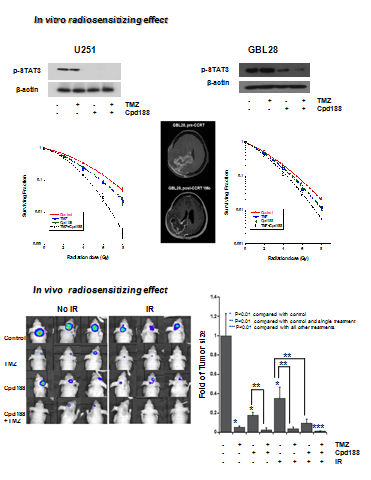글로벌 연구동향
방사선생물학
![[ J Neurooncol.]Inhibition of STAT3 enhances the radiosensitizing effect of temozolomide in glioblastoma cells in vitro and in vivo.](/enewspaper/upimages/admin_20161012154508_R.jpg) 2016년 10월호
2016년 10월호
[ J Neurooncol.]Inhibition of STAT3 enhances the radiosensitizing effect of temozolomide in glioblastoma cells in vitro and in vivo.서울의대/한태진, 김인아*
- 출처
- J Neurooncol.
- 등재일
- 2016 Aug 10
- 저널이슈번호
- 내용

AbstractEven with aggressive treatment involving radiation therapy plus temozolomide (TMZ), the prognosis for glioblastoma remains poor. We investigated the potential for targeting signal transducer and activator of transcription-3 (STAT3) to improve the therapeutic outcome in glioblastoma. We evaluated the preclinical potential of a STAT3 inhibitor, Cpd188, combined with temozolomide and radiation using in vitro assays with two established glioblastoma cell lines (U251 and U87) and two patient-derived glioblastoma cell lines (GBL12 and GBL28) as well as in vivo studies with nude mice bearing intracranial U251 xenografts. Cpd188 potentiated the radiosensitizing effect of TMZ in U251 cells, which have high p-STAT3 expression levels. The enhanced radiosensitizing effects of TMZ were associated with impaired DNA damage repair, apoptosis and reversion of the epithelial-mesenchymal transition (EMT). Cpd188 delayed in vivo tumor growth alone and in combination with radiation and TMZ. We also confirmed the radiosensitizing effect of Cpd188 in GBL28 cells, which were originated from a patient with a high level of STAT3 expression and unmethylated MGMT. Targeting STAT3 using Cpd188 could be a viable therapeutic approach for improving the outcome of current standard therapy in glioblastoma patients with high p-STAT3 expression.
Author information
Han TJ1, Cho BJ2, Choi EJ1,2, Kim DH2, Song SH1, Paek SH3,4, Kim IA5,6,7.
1Department of Radiation Oncology, Graduate School of Medicine, Seoul National University, Seoul, Republic of Korea.
2Department of Radiation Oncology, Medical Science Research Institute, Seoul National University Bundang Hospital, 166 Gumiro, Bundanggu, Seongnam, Kyeonggido, 13620, Republic of Korea.
3Cancer Research Institute, School of Medicine, Seoul National University, Seoul, Republic of Korea.
4Department of Neurosurgery, School of Medicine, Seoul National University, Seoul, Republic of Korea.
5Department of Radiation Oncology, Graduate School of Medicine, Seoul National University, Seoul, Republic of Korea. inah228@snu.ac.kr.
6Department of Radiation Oncology, Medical Science Research Institute, Seoul National University Bundang Hospital, 166 Gumiro, Bundanggu, Seongnam, Kyeonggido, 13620, Republic of Korea. inah228@snu.ac.kr.
7Cancer Research Institute, School of Medicine, Seoul National University, Seoul, Republic of Korea. inah228@snu.ac.kr.
- 키워드
- Glioblastoma; Radiosensitization; STAT3; Temozolomide
- 연구소개
- 교모세포종은 현재 표준치료인 수술 후 방사선치료와 temozolomide 병합치료만으로는 그 예후가 불량하여 치료성적을 향상시키기 위한 노력의 일환으로 특정 신호전달경로를 억제하는 방법이 시도되고 있습니다. 본 논문은 STAT3 specific inhibitor인 Cpd188을 이용한 병용치료가 치료효과을 향상시키는지 알아보고자 하였습니다. 다양한 악성교모세포종 환자 유래 세포주들을 대상으로 in vitro radiosensitizing effect를 screening 하였을때 pSTAT3 expression level이 높은 종양세포에서 Cpd188 병용 시 temozolomide의 방사선 감작효과를 더욱 증가시킴을 확인하였습니다. 이러한 병합효과의 주요기제로서는 DNA repair의 저해 및 apoptosis 증가, epithelial-mesenchymal transition (EMT)의 reversion등이 규명되었습니다. 인간 교모종의 xenograft를 이용하여 기존 표준치료 (방사선치료와 temozolomide 병합요법) 에 Cpd188을 병용하였을 때 종양의 성장 억제 효과가 가장 크게 나타남을 in vivo level에서도 검증하였습니다.
- 덧글달기
- 이전글 [Cancer Chemother Pharmacol.] Silencing of fused toes homolog enhances cisplatin sensitivity in cervical cancer cells by inhibiting epidermal growth factor receptor-mediated repair of DNA damage.
- 다음글 [ Int J Oncol.] The resveratrol analog HS-1793 enhances radiosensitivity of mouse-derived breast cancer cells under hypoxic conditions.







